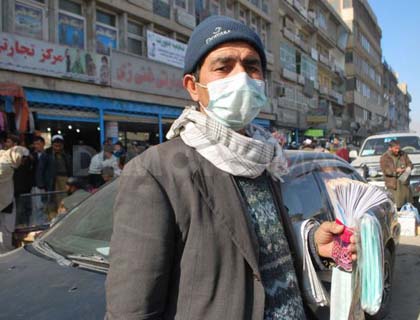Kabul, the capital of Islamic Republic of Afghanistan, is a city where according to health pundits, pollution forms greater threat to life of people than the insecurity does. The hundreds of thousands of vehicles have turned healthy breathing a dream while burning of coal and wood for heating purposes during cold season create monstrous black clouds of smoke that make sky almost invisible. Kabul is surrounded by dry mountains and the Kabul River that passes from the middle of the city is full of polluted water.
Lack of greenery and public parks has fuelled the problem of bad health. Awareness among the public in regards to help the environment become clean is at its lowest. Waste is thrown everywhere. In short, the capital in itself resembles a dustbin. Very unfortunately, the government of Afghanistan has not been able to turn Kabul look like a real capital. What other governments can do in a few months, the Afghan government has failed to do that in a decade.
Come out of home and expect what, a pall of smog and dust that hangs over Kabul's streets. It clings to the face, burns the eyes, and stains the hands. It bathes the cars, often stuck bumper-to-bumper in traffic, and occludes the view of the distant mountains.
Almost two 2 to 4 times a week unusually strong winds carrying dust from the parched land have increased respiratory and eye diseases in Kabul. Because of the climate change, environmental degradation and lack of vegetation, the wind is extremely strong and dusty every time and makes normal life very difficult. Many traffic accidents have been caused by these winds as everything almost becomes invisible.
The polluted air we breathe in Kabul has horrific consequences for our health. According to medical researches, the air pollution can cause or exacerbate a number of serious diseases among inhabitants of an air polluted city. These diseases include ischemic heart diseases, stroke, hypertension, and a number of respiratory diseases and birth defects.
Those who are at highest risk of being affected by air pollution are children, the elderly and patients who already have diabetes, heart disease and respiratory disease. Air pollution can also affect fetus in the mother's womb.
A large study in Los Angeles showed that air pollution due to carbon mono-oxide can increase birth defects. Knowing the high concentration of carbon mono oxide in Kabul, it is of great concern to us that birth defects may increase in Kabul. We need to wake up for the sake of giving a better health for our coming generations.
The primary reason for the air pollution in Kabul is the enormous amounts of smoke produced by badly maintained vehicles and factories located in the densely populated areas of the city. Improper traffic system and its inadequate and unprofessional personnel are adding fuel to the fire.
There are no any appropriate engine fitness inspections or restriction for vehicles producing the cloud-like smokes. On the other hand, the streets in Kabul represent the dirtiest streets of the world. The vehicles running on the shabby, rough and tough roads blow dust particles, waste materials and garbage which make breathing almost impossible. These roads and streets are the main sources of various kinds of deadly germs causing fatal diseases each day to hundreds of people including children.
On working days, almost every day, traffic goes crazy in Kabul. That is due the huge number of vehicles and lack of a proper public transport system. Every month Kabul's about one million vehicles are added to by more than 8,000 new vehicles registered with the Kabul traffic department. Many of these vehicles are over 15 years old while some are running since 80s. The problem in Kabul is compounded by the widespread use of substandard car fuel and old engines.
Power cuts and the absence of a national natural gas grid mean that many households use wood, coal and heating oil for cooking and heating. Moreover, some brick factories, public baths and small businesses burn old tyres, plastic and combustible waste to run their businesses more cheaply.
Toxic pollutants, sulfur oxide, carbon monoxide, nitrogen dioxide and carbon dioxide are emitted. Poor waste management – both solid and otherwise - is yet another major problem in Kabul which also damages the air quality. Unlike some other capital cities, Kabul has the added problem of its arid and mountainous landscape and lack of nearby woodlands.
Due to cost and pretty much little other alternatives, Afghans are forced to burn wood in order to keep warm and to cook their food. This, along with the fact that a large number of vehicles (many old and poorly maintained) in Afghanistan run on poor quality fuels, air pollution has become a problem in Afghanistan's major urban areas - like in the city of Kabul where it is clearly visible. In fact, a recent study revealed that 60% of Kabul's residents are exposed to increased levels of harmful toxins such as nitrous oxides, and sulfur dioxide.
There is no data on the population of Kabul. But it is estimated that about five million people are currently living in Kabul. In addition to rapidly growing population, Kabul today is facing a number of serious issues - a virtually non-existent sewage and sanitation system, burgeoning slums, crumbling infrastructure and so on.
Steps taken recently by the Kabul Municipality are appreciable but very minor as compared to the huge environmental issues this city is facing. The government has to stop sleeping like a log and act fast and execute a series of projects such as the rehabilitation of forests and promotion of greenery, ban the import and use of substandard fuel, improve waste management and at the same time build and strengthen our own institutional capacity. It is about the government and the people took steps in order to clean their environment, breath in a cleaner air and remain safe from various kinds of fatal diseases.

